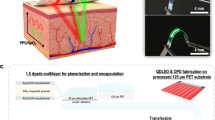Abstract
Pressure injuries (PI) are dangerous tissue lesions that heal very slowly and pose a high risk of serious infections. They are caused by pressure applied to the tissue, which stops blood circulation and therefore induces hypoxia, i.e., low tissue oxygen saturation (StO2). PI cause severe suffering and are expensive to treat. Hence it is essential to prevent them with a device that detects a dangerous situation, e.g., by measuring StO2 using near-infrared spectroscopy (NIRS). For such a device to be wearable without causing PI, it must not introduce pressure points itself. This can be achieved by integrating optical fibers into a textile to transport light to and from the tissue.
The aim of this paper is to investigate the accuracy of StO2 measurements using a NIRS device based only on textile-integrated optical fibers.
Bundles of fibers were stitched into a textile in such a way that loops of <1 mm diameters were formed at the stitching locations. Detection points (DPs) on the fabric consisted of 8 fibers with 3 loops each. Emission points (EPs) were made from 4 fibers with 3 loops each. All fiber ends of a DP were connected to an avalanche photodiode. One end of each fiber belonging to an EP was connected to an LED (740 nm, 810 nm, or 880 nm; 290, 560, or 610 mW).
To verify the accuracy of this textile-based sensor, we placed it on a subject’s forearm and compared the derived StO2 during arterial occlusion to the values of a gold-standard NIRS device (ISS Imagent), which was placed on the forearm too.
We found that our textile-based sensor repeatedly measured StO2 values over a range of 40% with a deviation of <10% from the reference device.
By showing the ability to measure StO2 using textile-integrated optical fibers accurately, we have reached a significant milestone on our way to building a wearable device to monitor tissue health and prevent PI.
Access this chapter
Tax calculation will be finalised at checkout
Purchases are for personal use only
Similar content being viewed by others
References
Berg G, Nyberg S, Harrison et al (2010) Near-infrared spectroscopy measurement of sacral tissue oxygen saturation in healthy volunteers immobilized on rigid spine boards. Prehosp Emerg Care 14:419–424
Mortenson WB, Miller WC (2008) A review of scales for assessing the risk of develo** a pressure ulcer in individuals with SCI. Spinal Cord 46:168–175
Damert H-G, Meyer F, Altmann S (2015) Therapieoptionen bei Dekubitalulzera. Zentralblatt für Chirurgie Zeitschrift für Allgemeine Viszeral- Thorax- und Gefäßchirurgie 140:193–200
Lutjemeier BJ, Ferreira LF, Poole DC et al (2008) Muscle microvascular hemoglobin concentration and oxygenation within the contraction–relaxation cycle. Respir Physiol Neurobiol 160:131–138
van der Zee P, Cope M, Arridge SR et al (1992) Experimentally measured optical pathlengths for the adult head, calf, and forearm and the head of the newborn infant as a function of inter optode spacing. Adv Exp Med Biol 316:143–153
ISO 80601-2-85:2021 (2021) Medical electrical equipment—part 2-85: particular requirements for the basic safety and essential performance of cerebral tissue oximeter equipment. https://www.iso.org/standard/72442.html
Suzuki S, Takasaki S, Ozaki T et al (1999) Tissue oxygenation monitor using NIR spatially resolved spectroscopy. Opt Tomogr Spectrosc Tissue III 3597:582–592
Hueber DM, Fantini S, Cerussi AE et al (1999) New optical probe designs for absolute (self-calibrating) NIR tissue hemoglobin measurements. In: Proceedings of SPIE 3597, optical tomography and spectroscopy of tissue III, vol 3597, pp 618–631
Pagano R, Libertino S, Sanfilippo D et al (2016) Improvement of sensitivity in continuous wave near infrared spectroscopy systems by using silicon photomultipliers. Biomed Opt Express 7(4):1183–1192
Acknowledgments
We gratefully acknowledge funding of the project by the SNSF and Innosuisse Bridge Discovery (project no. 180983).
Author information
Authors and Affiliations
Corresponding author
Editor information
Editors and Affiliations
Rights and permissions
Copyright information
© 2023 The Author(s), under exclusive license to Springer Nature Switzerland AG
About this paper
Cite this paper
Cantieni, T., da Silva-Kress, O., Wolf, U. (2023). Accuracy of Tissue Oxygen Saturation Measurements of a Textile-Based NIRS Sensor. In: Scholkmann, F., LaManna, J., Wolf, U. (eds) Oxygen Transport to Tissue XLIV. ISOTT 2022. Advances in Experimental Medicine and Biology, vol 1438. Springer, Cham. https://doi.org/10.1007/978-3-031-42003-0_14
Download citation
DOI: https://doi.org/10.1007/978-3-031-42003-0_14
Published:
Publisher Name: Springer, Cham
Print ISBN: 978-3-031-42002-3
Online ISBN: 978-3-031-42003-0
eBook Packages: Biomedical and Life SciencesBiomedical and Life Sciences (R0)




